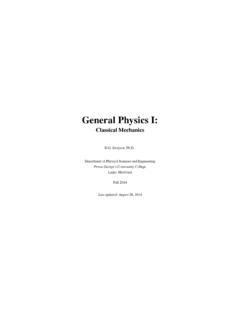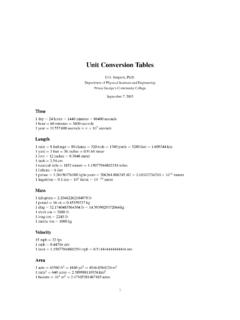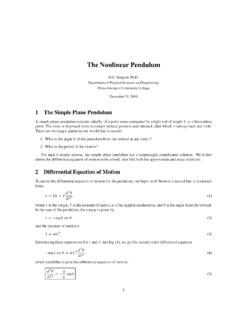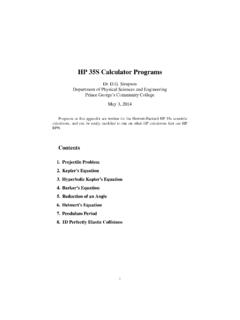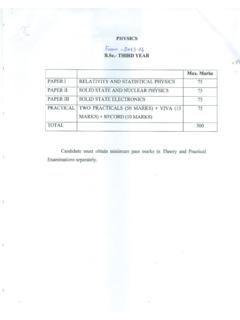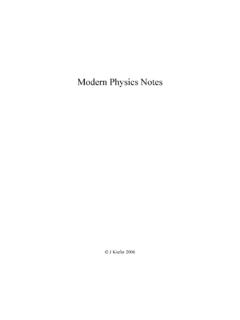Transcription of Introductory Physics II - pgccphy.net
1 Introductory Physics II:Waves, Acoustics, Electromagnetism, Optics, and modern Simpson, of Natural SciencesPrince George s Community CollegeLargo, MarylandSpring 2021 Last updated: September 14, 2020 ContentsAcknowledgments10 IPreliminaries111 What is Physics ? of Units.. Units .. Systems of Units .. Engineering Units .. as an Error-Checking Technique .. Conversions .. Units.. and Ends ..223 Problem-Solving Strategies234 The Numbers .. Calculus Finding Slopes .. Calculus Finding Areas .. Fundamental Theorem of Calculus .. Examples .. Ideas .. Further ..37 IIWaves385 Simple Harmonic .. Vertical Spring .. and Period .. on a Spring .. on the Spring Constant..441 Prince George s Community CollegeIntroductory Physics Simpson6 Damped .. Damped ..487 Forced ..498 The of Motion .. Spherical Pendulum .. Conical Pendulum.. Torsional Pendulum .. Physical Pendulum .. Pendulums.
2 Of Waves .. Speed .. Waves .. and Transmission .. Energy.. Intensity .. Waves .. Waves ..6510 Standing or Free at Both Ends.. at One End and Free at the Other .. of Rods and Plates .. of Sound .. of Sound ..7412 The Doppler Doppler Effect ..7613 Sound ..802 Prince George s Community CollegeIntroductory Physics Simpson14 The Edison .. Scales .. Notation .. Example .. Instruments ..90 IVElectricity and Charge .. s Law .. View of Electricity.. s Law in Two or Three Dimensions ..9617 The Electric Field due to a Point Charge .. Field Lines .. Electric Dipole .. Flux .. s Law .. Fields of Conductors .. Breakdown .. 10018 Electric Energy .. Surfaces .. between Gravity and Electricity.. Electron Volt .. 10319 The Battery10420 Electric .. in Series and Parallel.. Internal Resistance.. 11122 Ohm s Power .. 1133 Prince George s Community CollegeIntroductory Physics Simpson23DC Electric Diagrams.
3 Plots.. Simple Circuit.. Analysis Principles.. 11824 Kirchhoff s Circuit .. 12025 Electronic .. Probe .. Capacitor .. in Series and Parallel .. Materials in Capacitors .. Stored in a Capacitor.. 12727RC RC Circuit .. RC Circuit .. 13028 Other Electronic Diode .. Transistor .. Circuits .. 13229 The Electric Edison Incandescent Lamp .. Fluorescent Bulbs .. Diode (LED) Bulbs .. 13530 Electronics as a Electronics.. Electronics .. Radio.. Rocketry .. Satellites .. Electronics Projects .. Poles .. View of Magnetism .. 1414 Prince George s Community CollegeIntroductory Physics Simpson32 The Magnetic Field.. Field due to a Single Magnetic Pole .. Field Lines .. Magnetic Dipole .. Flux .. s Law for Magnetism .. Law .. Field due to a Long Wire .. Field of a Solenoid .. Magnetic Field of a Loop or Coil of Wire.
4 Torque on a Magnetic Dipole in a Magnetic Field .. Magnetic Pressure .. 14633 The Lorentz .. on a Wire in a Magnetic Field .. Force between Two Long Wires .. Hall Effect .. s Magnetic Dipole .. Declination .. Inclination .. Reversals .. Magnetosphere .. Aurora .. 15435 Magnetic .. Magnets .. Temperature .. Currents .. 16336 Amp`ere s Law16437 Faraday s s Law .. EMF .. 16738 Maxwell s Inductor .. in Series and Parallel .. Materials in Inductors .. Stored in an Inductor.. 1725 Prince George s Community CollegeIntroductory Physics Simpson40LR Circuits17341LC and LCR Circuits .. Circuits.. 17842AC Wars of the 19th Century: AC vs. DC .. Waves .. Ionosphere .. Crystal Radio .. Radio Transmitter .. 190 VOptics19346 Geometrical of Diagrams .. Method .. Mirrors .. s Law .. Internal Reflection.
5 Diagrams .. Method .. Fresnel Lens.. 20550 Optical Aberration .. Aberration .. 20651 Optical Magnifying Glass .. Human Eye .. Trilobite Eye .. Camera .. 2126 Prince George s Community CollegeIntroductory Physics Microscope .. Telescope .. Periscope .. Kaleidoscope .. Flux.. Intensity .. : The Sun .. : Incandescent Light Bulb .. Photometry .. 22053 Young s Effects .. Rayleigh Criterion.. in the Eye .. Diffraction Grating .. 22555 Optics of the Hubble Space Hubble Space Telescope.. Optics Overview .. Aberration .. Dispersion Formula .. Dispersion Formula .. Absorption.. ; Brewster s Law .. Colors .. Chromaticity Diagram.. 23759 The .. Primary Rainbow .. Secondary Rainbow .. of the Rainbow .. s Dark Band .. 2447 Prince George s Community CollegeIntroductory Physics Rainbows .. 245 VIModern Physics24960 Special.
6 Dilation .. Contraction .. Example .. of Velocities .. 25261 Superfluids25462 The Standard .. Higgs Boson .. 259 Further Reading260 Appendices263 AGreek Alphabet265 BTrigonometry266 CUseful Series272 DTable of Derivatives273 ETable of Integrals275 FMathematical Subtleties277 GSI Units279 HGaussian Units282 IUnits of Physical Quantities284 JPhysical Constants287 KAstronomical Data288 LUnit Conversion Tables2898 Prince George s Community CollegeIntroductory Physics SimpsonMAngular Angle .. Angle .. 293 NVector Arithmetic295 OMatrix Properties298 PMoments of Inertia300 QThe Simple Plane Pendulum: Exact of Motion .. , .t/.. 303 RCIE Chromaticity Coordinates307 SCalculator Programs309 TRight-Hand Rules310 UThe Earth s Magnetosphere311 VRound-Number Handbook of Physics314 WShort Glossary of Particle Physics316 XFundamental Physical Constants Extensive Listing317 YPeriodic Table of the Elements324 References324 Index3279 AcknowledgmentsThe author wishes to express his thanks to David Benning, Jay Nelson, and Glenn Snyder for their help withthe material on music in Chapter 15; and also to John McClure of Prince George s Community College formany valuable comments on the IPreliminaries11 Chapter 1 What is Physics ?
7 Physicsis the most fundamental of the sciences. Its goal is to learn how the Universe works at the mostfundamental level and to discover the basic laws by which it physicsconcentrateson developing the theory and mathematics of these laws, whileapplied physicsfocuses attention on theapplication of the principles of Physics to practical physicslies at the intersectionof Physics and engineering; experimental physicists have the theoretical knowledge of theoretical physicists,andthey know how to build and work with scientific is divided into a number of sub-fields, and physicists are trained to have some expertise in all ofthem. This variety is what makes Physics one of the most interesting of the sciences and it makes peoplewith Physics training very versatile in their ability to do work in many different technical major fields of Physics are: Classical mechanicsis the study the motion of bodies according to Newton s laws of motion.
8 Electricity and magnetismare two closely related phenomena that are together considered a single fieldof Physics . We ll study electricity and magnetism in this course. Quantum mechanicsdescribes the peculiar motion of very small bodies (atomic sizes and smaller). Opticsis the study of light, and we ll study it in this course. Acousticsis the study of sound; this is another subject we ll study in this course. Thermodynamicsandstatistical mechanicsare closely related fields that study the nature of heat. Solid-state physicsis the study of solids most often crystalline metals. Plasma physicsis the study of plasmas (ionized gases). Atomic, nuclear, and particle physicsstudy of the atom, the atomic nucleus, and the particles that makeup the atom. Relativityincludes Albert Einstein s theories of special and general relativityde-scribes the motion of bodies moving at very high speeds (near the speed of light), whilegeneral rela-tivityis Einstein s theory of fields ofcross-disciplinary physicscombine Physics with other sciences.
9 These includeastrophysics( Physics of astronomy),geophysics( Physics of geology),biophysics( Physics of biology),chemical Physics ( Physics of chemistry), andmathematical Physics (mathematical theories related to Physics ).12 Prince George s Community CollegeIntroductory Physics SimpsonBesides acquiring a knowledge of Physics for its own sake, the study of Physics will give you a broad tech-nical background and set of problem-solving skills that you can apply to wide variety of other fields. Somestudents of Physics go on to study more advanced Physics , while others find ways to apply their knowledgeof Physics to such diverse subjects as mathematics, engineering, biology, medicine, and 2 UnitsThe phenomena of Nature have been found to obey certain physical laws; one of the primary goals of physicsresearch is to discover those laws. It has been known for several centuries that the laws of Physics areappropriately expressed in the language ofmathematics, so Physics and mathematics have enjoyed a closeconnection for quite a long order to connect the physical world to the mathematical world, we need to makemeasurementsof thereal world.
10 In making a measurement, we compare a physical quantity with some agreed-upon standard, anddetermine how many such standard units are present. For example, we have a precise definition of a unit oflength called amile, and have determined that there are about 92,000,000 such miles between the Earth andthe is important that we have very precise definitions of physical units not only for scientific use, but alsofor trade and commerce. In practice, we define a fewbase units, and derive other units from combinations ofthose base units. For example, if we define units for length and time, then we can define a unit for speed asthe length divided by time ( miles/hour).How many base units do we need to define? There is no magic number; in fact it is possible to definea system of units using onlyonebase unit (and this is in fact done for so-callednatural units). For mostsystems of units, it is convenient to define base units for length, mass, and time; a base electrical unit mayalso be defined, along with a few lesser-used base Systems of UnitsSeveral different systems of units are in common use.
